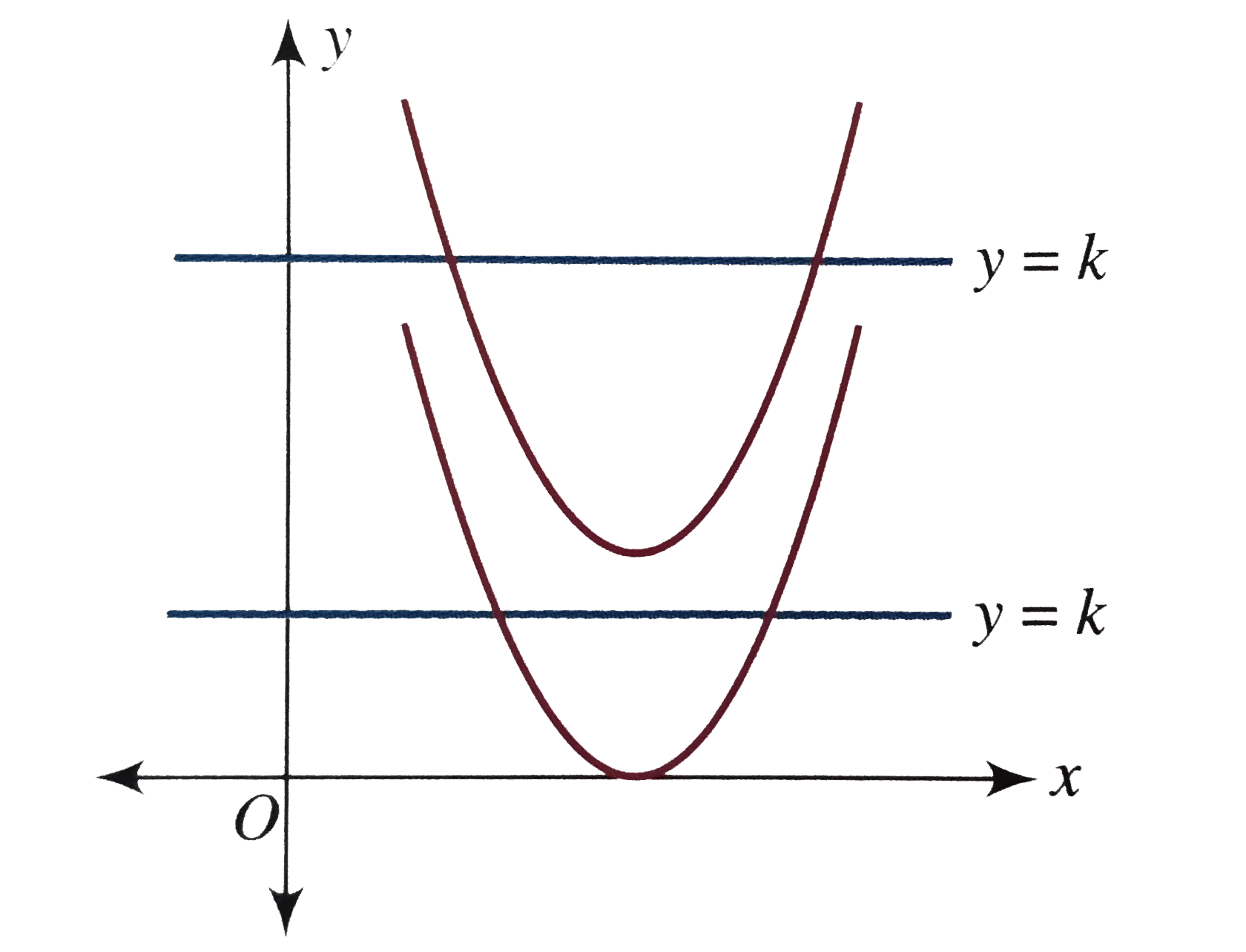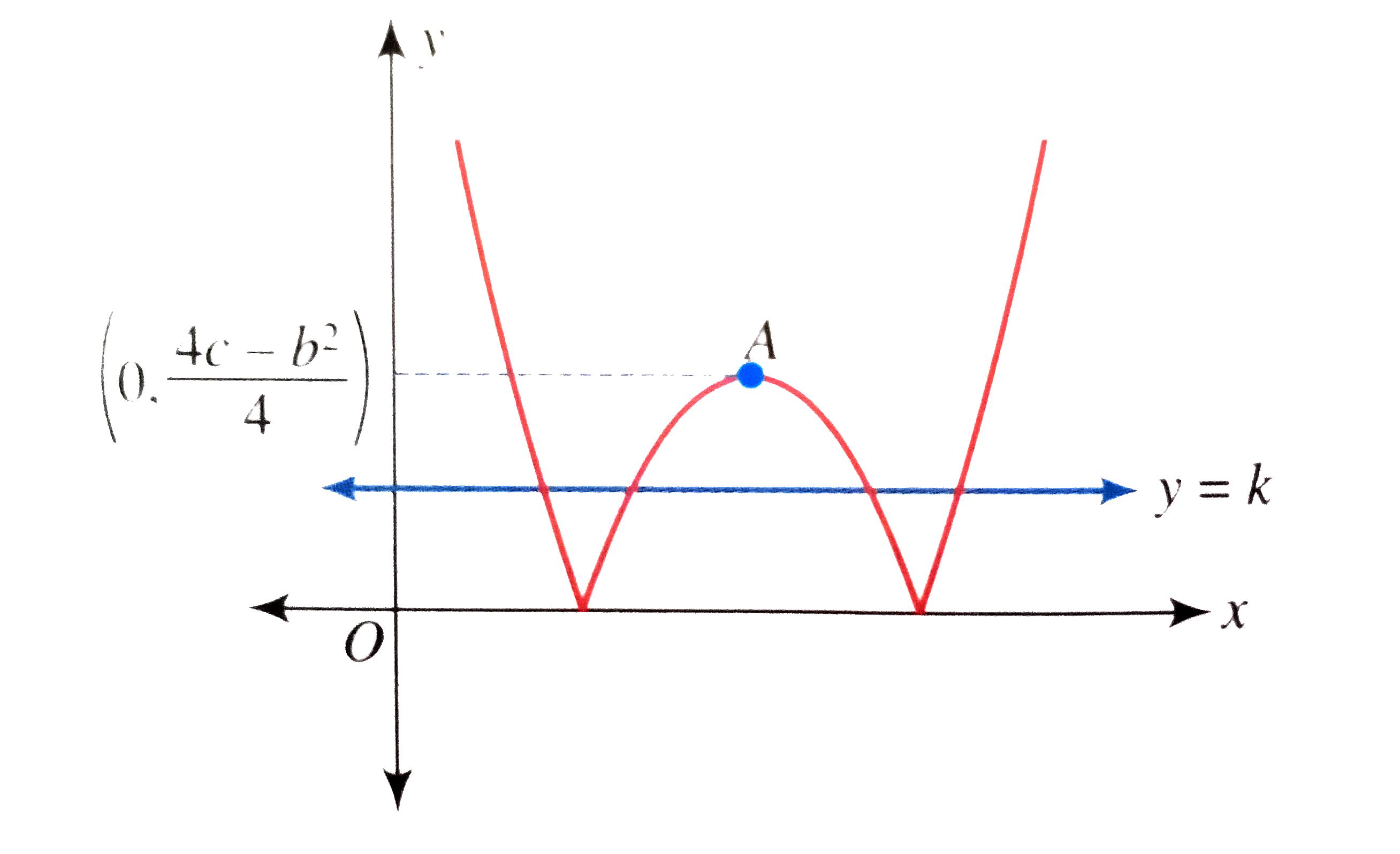If the equation ∣∣x2+bx+c∣∣=k has four real roots, then a. b2−4c>0 and 0<k<4c−b24 b. b2−4c<0 and 0<k<4c−b24 c. b2−4c>0 and k>4c−b24 d. none of theseSolution in Bengali
We have ∣∣x2+bx+c∣∣=k
For the equation to have four real roots, the line y=k must intersect y=∣∣x2+bx+c∣∣ at four points, which is not possible if D=0orD<0 as the possible graphas of y=∣∣x2+bx+c∣∣ will be as follows.

For the above graphs, the equation ∣∣x2+bx+c∣∣=k can have maximum two real roots. So for four real roots, we must have D>0, so the graph of y=x2+bx+c is as follows.

So the graph of y=∣∣x2+bx+c∣∣ will be as follows.

Now the equation ∣∣x2+bx+c∣∣=k will have four real if the line y=k intersects the above graph between the x-axis and point A.
Hence we have 0<k<4c−b24
Also D>0∴b2−4c>0.
Topper's Solved these Questions
Similar Questions
Draw the graph of y=tan−1x−cot−1x.
01:38View SolutionDraw the graph of y=(x−1)(x2−x+1).
01:04View Solutiona^(2)+b^(2)+4c^(2)=2a+2b-4c+3=0
05:00View SolutionIf the roots of x2−bx+c=0 are two consecutive integers, then b2−4c is 0 (b) 1 (c) 2 (d) none of these
03:29View SolutionIf both roots of the equation ax2+x+c−a=0 are imaginary and c>−1, then a.3a>2+4c b.3a<2+4c c.c<a d. none of these
03:57View SolutionIf the equation ∣∣x2+bx+c∣∣=k has four real roots, then
A. b2−4c>0and0<k<4c−b24
B. b2−4c<0and0<k<4c−b24
C.b2−4c>0andk>4c−b24
D. none of theseView SolutionConsider a circle x2+y2+ax+by+c=0 lying completely in the first quadrant. If m1andm2 are the maximum and minimum values of yx for all ordered pairs (x,y) on the circumference of the circle, then the value of (m1+m2) is (a)a2−4cb2−4c (b) 2abb2−4c (c)2ab4c−b2 (d) 2abb2−4ac
02:14View SolutionLet a,b,c,d∈R. If the equations 2bx2+3cx−d=0 and 2ax2+3bx+4c=0 have a common root and 4bc+adk(b2−ac)=bd+4c24bc+ad', then k =
04:44View SolutionIf the roots of the equation x2−bx+c=0 are two consecutive integers, then find the value of b2−4c
04:15View SolutionIf the equation ∣∣x2+bx+c∣∣=k has four real roots, then
A. b2−4c>0and0<k<4c−b24
B. b2−4c<0and0<k<4c−b24
C.b2−4c>0andk>4c−b24
D. none of these03:43View SolutionConsider a circle x2+y2+ax+by+c=0 lying completely in the first quadrant. If m1andm2 are the maximum and minimum values of yx for all ordered pairs (x,y) on the circumference of the circle, then the value of (m1+m2) is (a)a2−4cb2−4c (b) 2abb2−4c (c)2ab4c−b2 (d) 2abb2−4ac
02:38View SolutionIf the equation ∣∣x2+bx+c∣∣=k has four real roots, then a. b2−4c>0 and 0<k<4c−b24 b. b2−4c<0 and 0<k<4c−b24 c. b2−4c>0 and k>4c−b24 d. none of these
02:35View SolutionIf the roots of x2−bx+c=0 are two consecutive integers, then b2−4c is (a)0 (b) 1 (c) 2 (d) none of these
04:02View SolutionIf both roots of the equation ax2+x+c−a=0 are imaginary and c>−1, then a.3a>2+4c b.3a<2+4c c.c<a d. none of these
02:32View SolutionIf the equation ∣∣x2+bx+c∣∣=k has four real roots, then
A. b2−4c>0and0<k<4c−b24
B. b2−4c<0and0<k<4c−b24
C.b2−4c>0andk>4c−b24
D. none of these01:43View SolutionIf the roots of x2−bx+c=0 are two consecutive integers, then b2−4c is 0 (b) 1 (c) 2 (d) none of these
01:31View Solution

